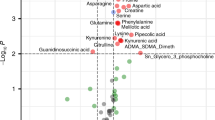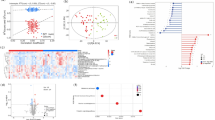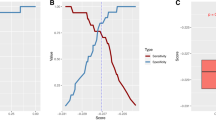Abstract
Background
We previously examined plasma metabolic changes before and after botulinum toxin-A injections of cerebral palsy (CP) children and showed that the glycine, serine and threonine metabolism may play a key role in neuritogenesis. This study analysed untargeted metabolomics combined with proteomics of plasma to discussed which substances are meaningfully changed, to what extent they affect the effects of action.
Methods
Blood samples were collected from 91 children with spastic CP at 4 time points: pre-injection (T1), 1 month post-injection (T2), 3 months post-injection (T3) and 6 months post-injection (T4). Differentially changed metabolites and proteins were selected, and co-expression pathways were constructed to explore the key molecular processes.
Results
A total of 674 proteins and 354 metabolites were identified. The differential metabolites were mainly involved in the linoleic acid metabolism, beta−Alanine metabolism, citrate cycle, pyruvate metabolism and glycolysis or gluconeogenesis. Differential proteins were primarily associated with glucose metabolism, lipid metabolism, immune and inflammation responses. Co-expression pathways showed that ECM-receptor interaction, complement and coagulation cascades, glycolysis or gluconeogenesis, pyruvate metabolism, and linoleic acid metabolism were the main pathways.
Conslusions
Our results indicated the botulinum toxin-A predominantly activated the glucose metabolism, lipid metabolism, and immune and inflammation responses, and energy metabolism changed significantly in this process.
Trial registration details
ChiCTR2000033800, Research on the mechanism of botulinum toxin relieving spasticity in children with cerebral palsy. Approval No. 202023041. Registered 13 June 2020, http://www.chictr.org.cn/showproj.html?proj=52267.
Impact statement
-
This is the first study that combined dynamic metabolomics and proteomics analysis to investigate the molecular changes in children with spastic cerebral palsy after botulinum toxin-A injections, which might provide a theoretical reference for the further subsequent study for targets to increase the efficacy and prolong the duration of botulinum toxin-A, and would be a valuable resource for the metabolomics and proteomics field in this group.
This is a preview of subscription content, access via your institution
Access options
Subscribe to this journal
Receive 14 print issues and online access
$259.00 per year
only $18.50 per issue
Buy this article
- Purchase on SpringerLink
- Instant access to full article PDF
Prices may be subject to local taxes which are calculated during checkout





Similar content being viewed by others
Data availability
The raw data supporting the conclusions of this article will be made available by the authors, without undue reservation.
References
Koman, L. A., Smith, B. P. & Shilt, J. S. Cerebral palsy. Lancet 363, 1619–1631 (2004).
Li, N. et al. In-depth analysis reveals complex molecular aetiology in a cohort of idiopathic cerebral palsy. Brain 145, 119–141 (2022).
Gulati, S. & Sondhi, V. Cerebral palsy: an overview. Indian J. Pediatr. 85, 1006–1016 (2018).
Yeargin-Allsopp, M. et al. Prevalence of cerebral palsy in 8-year-old children in three areas of the united states in 2002: a multisite collaboration. Pediatrics 121, 547–554 (2008).
Howard, J. et al. Cerebral palsy in victoria: motor types, topography and gross motor function. J. Paediatr. Child Health 41, 479–483 (2005).
Kaya Keles, C. S. & Ates, F. Botulinum toxin intervention in cerebral palsy-induced spasticity management: projected and contradictory effects on skeletal muscles. Toxins 14, 772 (2022).
Novak, I. et al. A systematic review of interventions for children with cerebral palsy: state of the evidence. Dev. Med. Child Neurol. 55, 885–910 (2013).
Aktaş, E. & Ömeroğlu, H. Botulinum toxin type a injection increases range of motion in hip, knee and ankle joint contractures of children with cerebral palsy. Eklem Hastalik Cerrahisi 30, 155–162 (2019).
Xu, K., Yan, T. & Mai, J. A randomized controlled trial to compare two botulinum toxin injection techniques on the functional improvement of the leg of children with cerebral palsy. Clin. Rehabil. 23, 800–811 (2009).
Blasi, J. et al. Botulinum neurotoxin a selectively cleaves the synaptic protein snap-25. Nature 365, 160–163 (1993).
Multani, I., Manji, J., Hastings-Ison, T., Khot, A. & Graham, K. Botulinum toxin in the management of children with cerebral palsy. Paediatr. Drugs 21, 261–281 (2019).
Lawrence, G. W., Ovsepian, S. V., Wang, J., Aoki, K. R. & Dolly, J. O. Therapeutic effectiveness of botulinum neurotoxin a: potent blockade of autonomic transmission by targeted cleavage of only the pertinent snap-25. Neuropharmacology 70, 287–295 (2013).
Tang, H. et al. Plasma metabolomic changes in children with cerebral palsy exposed to botulinum neurotoxin. J. Proteome Res. 21, 671–682 (2022).
Dar, M. A. et al. Multiomics technologies: role in disease biomarker discoveries and therapeutics. Brief. Funct. Genom. 22, 76–96 (2023).
Schrimpe-Rutledge, A. C., Codreanu, S. G., Sherrod, S. D. & McLean, J. A. Untargeted metabolomics strategies-challenges and emerging directions. J. Am. Soc. Mass Spectrom. 27, 1897–1905 (2016).
Alpay Savasan, Z. et al. Metabolomic profiling of cerebral palsy brain tissue reveals novel central biomarkers and biochemical pathways associated with the disease: a pilot study. Metabolites 9, 27 (2019).
Rifai, N., Gillette, M. A. & Carr, S. A. Protein biomarker discovery and validation: the long and uncertain path to clinical utility. Nat. Biotechnol. 24, 971–983 (2006).
Aebersold, R. & Mann, M. Mass spectrometry-based proteomics. Nature 422, 198–207 (2003).
Wang, X. K. et al. Tnap-a potential cytokine in the cerebral inflammation in spastic cerebral palsy. Front. Mol. Neurosci. 15, 926791 (2022).
Han, N. et al. Proteomic changes in rat gastrocnemius muscle after botulinum toxin a injection. Ann. Rehabil. Med. 37, 157–166 (2013).
Welham, N. V., Marriott, G., Tateya, I. & Bless, D. M. Proteomic changes in rat thyroarytenoid muscle induced by botulinum neurotoxin injection. Proteomics 8, 1933–1944 (2008).
Nasb, M. et al. Comparison of the effects of modified constraint-induced movement therapy and intensive conventional therapy with a botulinum-a toxin injection on upper limb motor function recovery in patients with stroke. Libyan J. Med. 14, 1609304 (2019).
Mauritz, K. H. Gait training in hemiplegia. Eur. J. Neurol. 9(Suppl 1), 23–29 (2002). dicussion 53-61.
Cavill, R., Jennen, D., Kleinjans, J. & Briedé, J. J. Transcriptomic and metabolomic data integration. Brief. Bioinform. 17, 891–901 (2016).
Garcia, A. & Barbas, C. Gas chromatography-mass spectrometry (Gc-Ms)-based metabolomics. Methods Mol. Biol. 708, 191–204 (2011).
Tsugawa, H., Tsujimoto, Y., Arita, M., Bamba, T. & Fukusaki, E. Gc/Ms based metabolomics: development of a data mining system for metabolite identification by using soft independent modeling of class analogy (Simca). BMC Bioinforma. 12, 131 (2011).
Kind, T. et al. Fiehnlib: mass spectral and retention index libraries for metabolomics based on quadrupole and time-of-flight gas chromatography/mass spectrometry. Anal. Chem. 81, 10038–10048 (2009).
David, C. C. & Jacobs, D. J. Principal component analysis: a method for determining the essential dynamics of proteins. Methods Mol. Biol. 1084, 193–226 (2014).
Ruiz-Perez, D., Guan, H., Madhivanan, P., Mathee, K. & Narasimhan, G. So you think you can pls-Da?. BMC Bioinforma. 21, 2 (2020).
Götz, S. et al. High-throughput functional annotation and data mining with the blast2go Suite. Nucleic Acids Res. 36, 3420–3435 (2008).
Ashburner, M. et al. Gene ontology: tool for the unification of biology. the gene ontology consortium. Nat. Genet. 25, 25–29 (2000).
Kanehisa, M. & Goto, S. Kegg: kyoto encyclopedia of genes and genomes. Nucleic Acids Res. 28, 27–30 (2000).
Kanehisa, M., Sato, Y., Kawashima, M., Furumichi, M. & Tanabe, M. Kegg as a reference resource for gene and protein annotation. Nucleic Acids Res. 44, D457–462 (2016).
Van Egeren, L. F. Multivariate statistical analysis. Psychophysiology 10, 517–532 (1973).
Meseguer-Henarejos, A. B., Sánchez-Meca, J., López-Pina, J. A. & Carles-Hernández, R. Inter- and intra-rater reliability of the modified ashworth scale: a systematic review and meta-analysis. Eur. J. Phys. Rehabil. Med. 54, 576–590 (2018).
Carr, W. W., Jain, N. & Sublett, J. W. Immunogenicity of botulinum toxin formulations: potential therapeutic implications. Adv. Ther. 38, 5046–5064 (2021).
Frevert, J. Pharmaceutical, biological, and clinical properties of botulinum neurotoxin type a products. Drugs R. D. 15, 1–9 (2015).
Li, J. et al. Adverse events after different forms of botulinum neurotoxin a injections in children with cerebral palsy: an 8-year retrospective study. Dev. Med. Child Neurol. 65, 86–93 (2023).
Panicker, J. N. & Muthane, U. B. Botulinum toxins: pharmacology and its current therapeutic evidence for Use. Neurol. India 51, 455–460 (2003).
Leach, M. W. et al. Immunogenicity/hypersensitivity of biologics. Toxicol. Pathol. 42, 293–300 (2014).
Nevin, A. N., Nguyen, K., Atresh, S., Vivanti, A. & Hickman, I. J. Effective management of spasticity and impacts on weight change and resting energy expenditure in a female with spinal cord injury: a case report. Spinal Cord. Ser. Cases 3, 17057 (2017).
Balaban, B., Tok, F., Tan, A. K. & Matthews, D. J. Botulinum toxin a treatment in children with cerebral palsy: its effects on walking and energy expenditure. Am. J. Phys. Med. Rehabil. 91, 53–64 (2012).
Edgar, T. S. Clinical utility of botulinum toxin in the treatment of cerebral palsy: comprehensive review. J. Child Neurol. 16, 37–46 (2001).
Dressler, D., Adib Saberi, F. & Rosales, R. L. Botulinum toxin therapy of dystonia. J. Neural Transm.128, 531–537 (2021).
de Paiva, A., Meunier, F. A., Molgó, J., Aoki, K. R. & Dolly, J. O. Functional repair of motor endplates after botulinum neurotoxin type a poisoning: biphasic switch of synaptic activity between nerve sprouts and their parent terminals. Proc. Natl. Acad. Sci. USA 96, 3200–3205 (1999).
Yin, G. N. et al. Establishment of in vitro model of erectile dysfunction for the study of high-glucose-induced angiopathy and neuropathy. Andrology 5, 327–335 (2017).
Goyal, M. S., Hawrylycz, M., Miller, J. A., Snyder, A. Z. & Raichle, M. E. Aerobic glycolysis in the human brain is associated with development and neotenous gene expression. Cell Metab. 19, 49–57 (2014).
Vander Heiden, M. G., Cantley, L. C. & Thompson, C. B. Understanding the warburg effect: the metabolic requirements of cell proliferation. Science 324, 1029–1033 (2009).
Goodyear, L. J. & Kahn, B. B. Exercise, glucose transport, and insulin sensitivity. Annu. Rev. Med. 49, 235–261 (1998).
Pedersen, B. K. & Hoffman-Goetz, L. Exercise and the immune system: regulation, integration, and adaptation. Physiol. Rev. 80, 1055–1081 (2000).
Scheffer, D. D. L. & Latini, A. Exercise-induced immune system response: anti-inflammatory status on peripheral and central organs. Biochim. Biophys. Acta Mol. Basis Dis. 1866, 165823 (2020).
Simpson, R. J., Kunz, H., Agha, N. & Graff, R. Exercise and the regulation of immune functions. Prog. Mol. Biol. Transl. Sci. 135, 355–380 (2015).
Loescher, C. M., Hobbach, A. J. & Linke, W. A. Titin (Ttn): from molecule to modifications, mechanics, and medical significance. Cardiovasc Res. 118, 2903–2918 (2022).
Legerlotz, K., Matthews, K. G., McMahon, C. D. & Smith, H. K. Botulinum toxin-induced paralysis leads to slower myosin heavy chain isoform composition and reduced titin content in juvenile rat gastrocnemius muscle. Muscle Nerve 39, 472–479 (2009).
Velders, M. et al. Effect of botulinum toxin a-induced paralysis and exercise training on mechanosensing and signalling gene expression in juvenile rat gastrocnemius muscle. Exp. Physiol. 93, 1273–1283 (2008).
Lieber, R. L., Roberts, T. J., Blemker, S. S., Lee, S. S. M. & Herzog, W. Skeletal muscle mechanics, energetics and plasticity. J. Neuroeng. Rehabil. 14, 108 (2017).
Heidings, J. B., Demosthene, B., Merlino, T. R., Castaneda, N. & Kang, E. H. Gelsolin-mediated actin filament severing in crowded environments. Biochem. Biophys. Res. Commun. 532, 548–554 (2020).
Miller, W. L. Tenascin-X-discovery and early research. Front. Immunol. 11, 612497 (2020).
Acknowledgements
The authors gratefully acknowledge the extraordinary generosity of the study participants and the support from their caregivers. And we would like to thank Dr. Luo Jie for polishing the language of the article. The study was funded by the Featured Clinical Technique of Guangzhou (2023C-TS59), Guangzhou Municipal Science and Technology Project (2024A03J01274, 2023A03J0919), and Plan on enhancing scientific research in Guangzhou Medical University (GMUCR2024-02020).
Author information
Authors and Affiliations
Contributions
K.S.X. contributed to conception and design, and final approval of the version to be published; Z.F.C. and T.T.P.a. wrote this manuscript and performed data analysis; M.R.Z., Y.G.Z. and H.R.N. carried acquisition of data; X.B.Y., Y.Z., T.T.P.b., Q.F.H., H.Y.Z., L.R.L. and M.S.H. carried out sample collection and revised the paper. H.M.T., L.H. and J.L.L. participated in participants recruitment.
Corresponding author
Ethics declarations
Competing interests
The authors declared no competing interests.
Ethics statement
This study was approved by the Health Research Ethics Committee of Guangzhou Women and Children’s Medical Centre (Approval No. 202023041). Informed consent was obtained from all participants in the study.
Additional information
Publisher’s note Springer Nature remains neutral with regard to jurisdictional claims in published maps and institutional affiliations.
Supplementary information
Rights and permissions
Springer Nature or its licensor (e.g. a society or other partner) holds exclusive rights to this article under a publishing agreement with the author(s) or other rightsholder(s); author self-archiving of the accepted manuscript version of this article is solely governed by the terms of such publishing agreement and applicable law.
About this article
Cite this article
Chen, Z., Peng, T., Zhong, M. et al. Integrated metabolomics and proteomics analysis in children with cerebral palsy exposed to botulinum toxin-A. Pediatr Res (2025). https://doi.org/10.1038/s41390-025-04038-5
Received:
Revised:
Accepted:
Published:
DOI: https://doi.org/10.1038/s41390-025-04038-5



